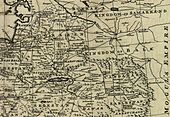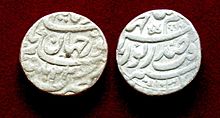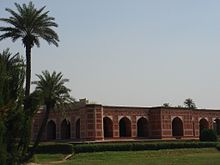- Nur Jahan
-
Begum Nur Jahan Mughal Empress 
Spouse Sher Afghan Quli Khan
JahangirIssue Mehr-Un-Nisaa House Timurid Father Mirza Ghias Beg Mother Asmat Begum Born 1577
Kandahar, Mughal EmpireDied 1645
Lahore, Mughal EmpireBurial Shahdara Bagh, Lahore Religion Islam Begum Nur Jahan (Persian/Urdu: نور جہاں ) (alternative spelling Noor Jahan, Nur Jehan, Nor Jahan, etc.) (1577–1645), also known as Mehr-un-Nisaa, was an Empress of the Mughal Dynasty that ruled much of the Indian subcontinent. She is an aunt of Empress Mumtaz Mahal, Emperor Shah Jahan's wife for whom the Taj Mahal was made.
Begum Nur Jahan was the twentieth and favourite wife of Mughal Emperor Jahangir, who was her second husband - and the most famous Empress of the Mughal Empire. The story of the couple's infatuation for each other and the relationship that abided between them is the stuff of many (often apocryphal) legends. She remains historically significant for the sheer amount of imperial authority she wielded - the true "power behind the throne," as Jehangir was battling serious addictions to alcohol and opium throughout his reign - and is known as one of the most powerful women who ruled India with an iron fist.
Contents
Birth
Begum Nur Jahan was born in 1577 in Kandahar (now in Afghanistan) to traveling Persian, Mirza Ghiyas Beg from Tehran (now in Iran). Her Persian-born grandfather, who was in the service of Shah Tahmasp I, died in Yazd, laden with honours. His heirs, however, soon fell upon hard times. His son Mirza Ghias Beg (known as Itmad-ud-Daulah, "Pillar of the State", a title conferred on him by Akbar) travelled to South Asia with his family where he rose to become an administrative official in the Mughal court. For their journey, Ghias Beg and his wife, Asmat Begum, joined a caravan travelling southward under the leadership of a merchant noble named Malik Masud. While still in Persian territory, less than half the way to their destination, Ghias Beg's party was attacked by robbers and the family lost almost everything it owned. Left with only two mules, Ghias Beg, his expectant wife, their children, Muhammad Sharif, Abdul Hasan Asaf Khan, and one daughter, took turns riding on the backs of the animals. When the group reached Kandahar, Asmat Begum gave birth to her fourth child and second daughter, Mehr-un-Nisaa.
Marriage with Sher Afgan
Mehr-Un-Nisaa was married to Sher Afgan Quli Khan when she was seventeen in 1594, the marriage arranged by Akbar. In 1605, Mehr-Un-Nisaa gave birth to a daughter, also called Mehr-Un-Nisaa (later at court she was named Ladli), Mehr-Un-Nisaa was the one and only child she ever had. In 1607, Sher Afghan Quli Khan was killed during a misunderstanding. During this time Sher Afgan Quli Khan had held the title of Sher Afgan, granted to him by Jahangir as Quli saved his life from an angry tigress. Also, during this time, Jahangir may have been asking Sher Afgan Quli Khan to give Mehr-Un-Nisaa to him, for his harem, although the truth of this is uncertain, as Jahangir married her in 1611, after she had been at court (see below) for four years.
Marriage with Jahangir
The emperor Akbar died in 1605 and was succeeded by prince Salim, who took the regal name Jahangir. After her husband Sher Afghan (who was appointed as jagirdar of Bardhaman, a city in Bengal) was killed in 1607, Mehr-un-Nisaa became a lady-in-waiting to one of the Jahangir's stepmothers, Ruqayya Sultana Begum. Ruqayya was the most senior woman in the harem and had been Akbar's first and principal wife and was also the daughter of Mirza Hindal. The father of Mehr-un-Nisaa was, at that time, a diwan to an amir-ul-umra, decidedly not a very high post.
The year 1607 had not been particularly good for Mehr-un-Nisaa. Her family had fallen into disgrace. Her father, who had been holding important posts under Akbar and Jahangir, had succumbed to his only weakness, money, and had been charged with embezzlement. Moreover, due to possible involvement in the pro-Khusrau assassination attempt on Jahangir in 1607, two of Mehr-un-Nisaa's family members (one brother named Muhammad Sharif and her mother's cousin) were executed on the orders of the Emperor.
In March 1611, her fortune took a turn for the better. She met the emperor Jahangir at the palace meena bazaar during the spring festival Nowruz new year. Jahangir grew so infatuated by her beauty that he proposed immediately and they were married on May 25 of the same year becoming his twentieth wife.
Mughal empress
For Mehr-un-Nisaa's own immediate family, marriage to Jahangir became a great boon with several members receiving sizeable endowments and promotions as a result. This affection led to Nur Jahan wielding a great deal of actual power in affairs of state. The Mughal state gave absolute power to the emperor, and those who exercised influence over the emperor gained immense influence and prestige. Jahangir's addiction to opium and alcohol made it easier for Nur Jahan to exert her influence. For many years, she effectively wielded imperial power and was recognized as the real force behind the Mughal throne. She even gave audiences at her palace and the ministers consulted with her on most matters. Indeed, Jahangir even permitted coinage to be struck in her name, something that traditionally defined sovereignty.
Through Nur Jahan's influence, her family, including her brother Asaf Khan, consolidated their position at court. Asaf Khan was appointed grand Wazir (minister) to Jahangir, and his daughter Arjumand Banu Begum (later known as Mumtaz Mahal) was wed to Prince Khurram (the future Shah Jahan), the third son of Jahangir, born by the Rajput princess, Jagat Gosaini. Jahangir's eldest son Khusrau had rebelled against the Emperor and was blinded as a result. The second son, Parviz, was weak and addicted to alcohol. The fourth son was Prince Shahryar, born by a royal concubine. Khurram rebelled against his father and a war of succession broke out. Due to Khurram's intransigence, Nur Jahan shifted her support to his younger brother, Shahryar. She arranged the marriage of her own daughter Ladli Begum, born of her first marriage, to her stepson Shahryar.[1] The two weddings ensured that one way or another, the influence of Nur Jahan's family would extend over the Mughal Empire for at least another generation.
Jahangir was captured by rebels in 1626 while he was on his way to Kashmir. Nur Jahan intervened to get her husband released. Jahangir was rescued but died on October 28, 1627. After Jahangir's death, Nur Jahan devoted some of her life to the making of perfume, particularly using falanja, an art form her mother had passed down.
Death
When Jahangir died in 1628, Nur Jahan's brother Asaf Khan took the side of his son-in-law Khurrum against his sister. It was Khurram who became the new Mughal emperor under the regal name Shah Jahan. Nur Jahan was confined to a comfortable mansion for the rest of her life.
During this period, she paid for and oversaw the construction of her father's mausoleum in Agra, known now as Itmad-Ud-Daulah's Tomb, and occasionally composed Persian poems under the assumed name of Makhfi.[1]
Nur Jahan died in 1645 at age 68, and is buried at Shahdara Bagh in Lahore, Pakistan in a tomb she had built herself, near the tomb of Jahangir. Her brother Asaf Khan's tomb is also located nearby. The tomb attracts many visitors, both Pakistani and foreign, who come to enjoy pleasant walks in its beautiful gardens. All had been personally laid out and designed by Nur Jahan herself.
Nur Jahan in Pop Culture
- Novelist Indu Sundaresan has written two books revolving around the life of Nur Jahan, The Twentieth Wife and The Feast of the Roses
- Nur Jahan's Daughter by Tanushree Podder also provides an insight into the life and journey of Nur Jahan from being a widow to the Empress and after, as seen from the perspective of her daughter.
See also
References
- ^ a b Nur Jahan's power... Ain-i-Akbari, by Abul Fazl,Vol I, chpt. 305.
Further reading
- Nur Jahan: Empress of Mughal India, by Ellison Banks Findly, Oxford University Press US. 2000. ISBN 0195074882.excerpts online
External links
Categories:- Mughal nobility
- 1577 births
- 1645 deaths
- Indian female royalty
Wikimedia Foundation. 2010.



